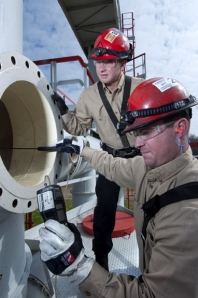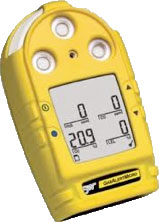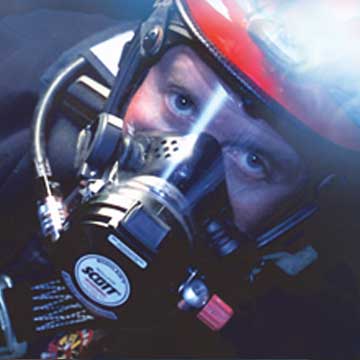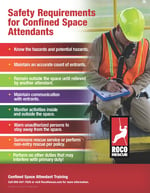Atmospheric Monitors May NOT Detect All Dangers
Readings are 20.9/0/0/0…so it must be safe for entry, right? Not necessarily!

After completing an interesting confined space standby job for Roco, I wanted to caution rescuers about the possibilities of atmospheric hazards within a confined space – despite what the atmospheric monitor says!
For this particular job, the atmosphere in the workspace never varied on the 4-gas monitor readings. The readings were consistently 20.9% for O2; 0 for LEL; 0 for H2S; and 0 for CO. However, this entry required the use of air-purifying respirators even though there were no visible signs of anything unusual – no odor, no product warning signs, no indication that there may be an inhalation hazard in the space.
This particular space was located at a public water facility. It was a 70-ft. deep concrete metering pit with six consecutive 12-ft x10-ft levels. It had concrete floors and walls with a vertical ladder that accessed each level. Although the space was not designed to store any product, in this case, we still had an atmospheric hazard.
 The purpose of the entry was for remediation of mercury contamination on the concrete surface. The gross cleanup of liquid mercury had been performed years prior, but further action was required to eliminate vapor hazards still present in the lower chambers.
The purpose of the entry was for remediation of mercury contamination on the concrete surface. The gross cleanup of liquid mercury had been performed years prior, but further action was required to eliminate vapor hazards still present in the lower chambers.
During the first phases of the entry, vapor levels that exceeded 40,000 ng/m3 (nano-grams per cubic meter) were detected. The more frequently updated ACGIH Threshold Limit Value is only 25,000 ng/m3. The work environment in this space routinely approached twice this level, even though there were no visible signs of liquid mercury. The source of the toxic atmospheric hazard was invisible and odorless – mercury vaporizing from the concrete surfaces.
Mercury is only one example of a toxicant that can produce a hazardous atmosphere in confined spaces that will not be indicated on a typical 4-gas meter or atmospheric monitor. Many rescuers assume that their 4-gas meter will detect all atmospheric conditions that may present a risk to their health or safety, but this is just not true. There are a wide variety of agents or toxicants besides mercury that will not be detected and whose presence may require other controls or the use of respiratory protection. This mistake could be deadly, or leave rescuers with chronic health issues.
In this scenario, for example, if you were an off-site rescuer responding to the above described space in an emergency situation. Without someone on site to inform you of the possible hazard, you would have no indication that any hazards were present. Many times as municipal rescuers we respond to, shall we say, shady locations where unauthorized storage or illegal dumping of hazardous products has taken place; there are no SDS, placards, or signage. Personnel on scene may not know, or may not want to relay vital information about a space of any products within the space.

Rescuers Beware: It's important to play the role of “detective” when planning or preparing to make a confined space entry.
Oftentimes, there are placards or signs on tanks or storage containers to start the investigation into what hazards may be present – and SDS for additional information. However, as rescuers, we often fall into a state of “false security” with our 4-gas meter readings.
While much of our training may include “Go/No Go” scenarios for rescue teams, the use of respiratory protection is usually based on one of the “Big 4” readings on our atmospheric monitors. Unfortunately, this may only serve to reinforce the notion that a 4-gas monitor will always provide the “complete” information of what may be going on inside a confined space. We get dependent on these monitors to tell us if it’s safe to enter without respiratory protection – and there may be much more to the story!
OSHA’s Respiratory Standard [1910.134 (d)(1)(III)] specifies "Where the employer cannot identify or reasonably estimate the employee exposure, the employer shall consider the atmosphere to be IDLH.”
In the above statement, if you substitute Team Leader for “employer” and “Rescue Team” for employee, you may find that you cannot “identify or reasonably estimate the employee exposure.” Therefore, rescuers would need to use SCBA/SAR and other PPE until you can completely identify what hazards are in the space even though typical monitoring devices are telling us that all is well.

While your standard 4-gas meter is an important screening tool – it is NOT a "catch all" for every atmospheric hazard.
Remember that NIOSH statistics indicate that 40%-60% of confined space entry fatalities are (would-be) rescuers, including both dedicated on-site standby teams and off-site professional rescuers (municipalities) who attempt to perform confined space rescues.
But let’s take this a step further. If you ask most rescuers at what O2 level does an atmosphere become dangerous, they will say below 19.5%. I know from my initial hazmat/confined space training on 4-gas monitors included oxygen displacement. It was so elegantly described to me as “if your monitor shows a decrease in oxygen, it is telling you that something else has pushed out that percentage of oxygen and replaced it with some other agent.” Now, it would be up to you to figure out what else is in the air.
For example, normal breathing air is 20.9%. To get a reading of 19.5% means that about 1.4% of “something else” has displaced the oxygen. Then, depending on what that “something else” is, could require the use of respiratory protection. Hey, wait, the good news keeps coming, and I am getting in way over my head on this science stuff, but my high school chemistry teacher should still be proud. Ambient air is made up of about 79% nitrogen and other gases and 21% oxygen. So, using fingers and toes mathematics, that equals about a 4:1 ratio of nitrogen to oxygen.
In other words, if we have a 1% displacement of oxygen from the breathing air, it will be accompanied by about a 4% displacement of nitrogen (both gases displace at about the same rate). Therefore, instead of it being about a 1.4% percent of an unknown product in our breathing air, it could be as much as 5.6% or more! And, depending on what that product is, it could already be at its IDLH level.
Project Scientist Spencer Pizzani of Weston Solutions provides this insight.
"While many rescuers are habituated to only watch oxygen (O2) percent composition, this can be deceptive. The OSHA standard for O2 concentration is based on standard temperatures and pressures at sea level. When an environment presents lower pressure (such as at higher altitudes or in chambers subject to continuous air evacuation), the partial pressure of O2 is decreased as described by the Ideal Gas Law. This can lead to 'normal’ concentrations, but with less oxygen available for respiration.
A widely used example demonstrates that the partial pressure of oxygen in a confined space at high altitudes such as in mountainous areas would be the equivalent partial pressure of 14-15% oxygen at sea level. This can be low enough for the leading effects of asphyxiation to manifest – a problem exacerbated by the high oxygen demand of strenuous rescue work.
Gases that displace oxygen can have a similar effect. A typical 4-gas meter will only read oxygen concentration. This neglects the largest component of ambient air – nitrogen. The portion of air normally occupied by nitrogen is also replaced by another gas. When taken as a whole, the contaminant gasses may exceed levels and require the use of respiratory protection, with no indication from the typical 4-gas meter. Many toxic gases are odorless and colorless. Radiation can be a similar risk. While some types of radiation can be filtered or excluded with the use of respiratory protection, exposure to other types are simply a function of time, distance and shielding. Rescuers entering confined spaces may have a strict time limit for operations as established by a health physicist. In such cases, a 4-gas meter would be entirely unresponsive even in the presence of an instantly lethal radiation exposure vector.”
Pizzani advises,
“Rescuers responding to an emergency always need to look at the big picture and be part detective in identifying potential hazards that may impact both initial and rescue entry. Identification of past residues in storage containers, examination of process system SDS, and any information/knowledge provided by workers familiar with the space or process is invaluable. Warning signs such as odors, visible dust, or any variability on oxygen concentration should be met with a thorough set of instrument diagnostics and further investigation.”
Summary
A standard 4-gas meter is an important screening tool for atmospheric acceptability. However, it is "not a catch all" for every atmospheric hazard. Developing a detailed preplan; identifying possible hazards; and proper PPE should be the top priority of anyone planning a rescue entry. The use of supplied air systems (SAR/SCBA) should be considered “minimum protection” for rescuers until an atmosphere is completely characterized or in the event of an unknown agent or condition. Remember, a standard 4-gas meter may not be telling the whole story.
Special thanks to contributing author, Spencer Pizzani, who is an Industrial Hygienist and Project Scientist for Weston Solutions, Inc. Weston is a global environmental consulting firm specializing in environmental solutions, specialty construction and green development.

Additional Resources
- Attendant Safety Requirements Poster (pictured here)
- Confined Space Entry Checklist
- Common Causes of Confined Space Fatalities
- Confined Space Types - Are All Your Bases Covered?




